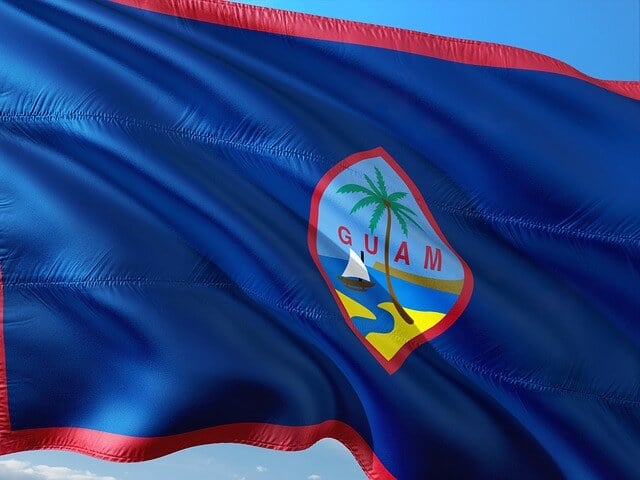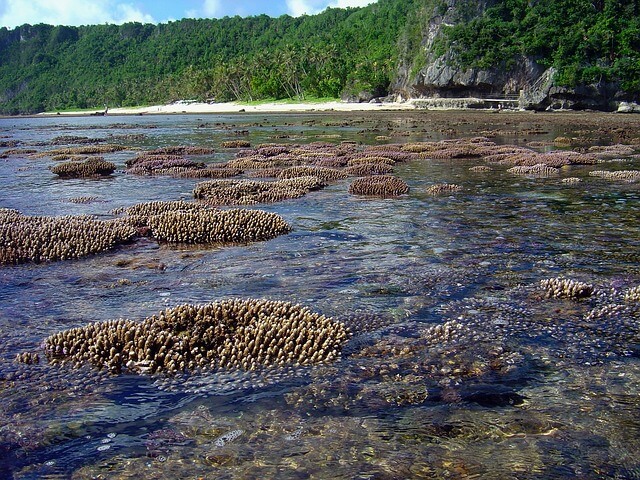Guam: an American treasure to be discovered
01 Dec 12:33

According to Chamorro mythology, Fu’ua created the cosmos in response to his brother Puntan’s final will and testament. When he was completed, he picked the island of Guam as a resting spot and turned into an intimidating rock.
Thus starts Guam’s millenary history, marked by a succession of peoples and dominions that have left indelible traces on the island’s culture.
Although the Chamorro first landed on the island circa 2000 BC, Ferdinand Magellan first visited its western coastlines in 1521. Years later, in 1565, Guam was formally designated a Spanish possession. Guam became a formal US colony only in 1898, following the Spanish-American War.
Unfortunately, the island’s history of dominance and invasion did not cease with that pact. To reclaim control of the island, the US forces had to engage the Japanese in the legendary Battle of Guam in 1944. Following the conflict, the lovely island was integrated into the United States’ unorganised territories.
In this post, we will create a map of the island of Guam, complete with locations to visit and activities to ensure a great holiday.
Where is Guam located?
Guam is located in Micronesia, one of Oceania’s macroregions, which is made up of many islands in the western Pacific Ocean. Micronesia’s islands are divided into four major archipelagos, with Guam being the southernmost island in the Mariana archipelago. With a surface area of 549 square metres, this island is the biggest in its archipelago and the whole macro-region.
Guam is located 2,400 kilometres from the Philippines and 5,300 kilometres from Hawaii, and can be reached in 7 hours by plane from Honolulu.
The island’s area is divided into two parts: the northern section, which has a coral plateau, and the green hills to the south, which are a volcanic structure. Furthermore, coral reefs entirely encircle Guam’s beaches.
The famed Mariana Trench, the deepest place on our globe, is located southwest of the island. In reality, Guam is nothing more than the pinnacle of an 11,000-meter-high seamount that rises from the pit’s bottom to the surface.
When to visit the island of Guam?
Here is some weather information to help you plan your vacation when it is most convenient for you.
Guam’s climate is tropical, hence the island experiences a humid heat, with temperatures averaging 32° during the day and 25° at night. Although the heat virtually crystallises the island in a perpetual summer, there is considerable rainfall between July and November. The rains are less frequent between January and April.
Cyclones must also be considered while going to tropical destinations. Cyclones are common in Guam between May and December, particularly between August and November. The best months to plan a vacation in Guam are thus between February and April.
How to reach Guam?
Stopovers in other countries will be required to reach the island of Guam from Italy. Antonio Borja Won Pat Airport, located in Tamuning and Barrigada, is the island’s sole airport.
The airport is well connected to Honolulu, and from there, Guam is only a 7-hour flight away. This is the best option since, because both are US territory, you won’t have to get any additional documentation or licences. There are also flights linking Guam and Los Angeles.
What documents do I need to go to Guam?
In fact, in order to enter the United States and its unincorporated territories, the following documents must be obtained:
- ESTA: The ESTA authorisation permits people of VWP nations, like as Italy, to travel to US territory for a maximum of 90 days. A answer is obtained within 72 hours after the query is filed online.
- Passport: If you wish to go to the United States or its unincorporated territories, you must now have an electronic passport. If you are travelling with youngsters, you should be aware that they, too, must obtain an individual electronic passport in order to exit the country.
- The return ticket is essential to establish that tourists do not plan to stay in the nation longer than the 90 days authorised by the ESTA.
Villages and places to visit in Guam

Deserted beach in Guam
The island of Guam is ideal for individuals who wish to detach from their hectic daily lives by lounging down in the sun with a beverage. With its lovely sandy beaches and crystal blue seas, this island truly seems like it is always summer. But Guam has much more to offer, and even the most ardent and curious travellers would be glad they picked it as a destination.
Guam is split into 19 villages or municipalities, and there are activities and places to visit in almost every one of them. Guam has it all for tourists interested in history, shopping, or sports. Let’s have a look at different communities and decide where to go.
Agana Heights
Prior to the arrival of the immigrants, this settlement was largely utilised as farmland by the residents of the adjacent capital Hagta. Agana Heights is now a wonderful multi-ethnic hamlet.
Fort Santa Agueda is a Spanish stronghold that was constructed between 1700 and 1800. The view from the fort is breathtaking, with views of the city, the Philippine Sea, and the peaks of Oka and Urunao Point.
Agath
Agat, located south of the US base Guam, is the commercial hub of Guam. You may visit various historical places in addition to shopping at the many stores on the main street.
- Agat Beach was chosen as one of the landing locations for American forces during the Battle of Guam in 1944. Signs with information on the combat, memorials, and historical relics are dispersed across the area, which is part of the War in the Pacific National Historic Park.
- Agat World War II Amtrac: still part of the national park, the wreck of this amphibious assault vehicle was discovered 460 metres off the shore of Agat.
- Taelayag and Taleyfac Spanish Bridges are two arched stone bridges erected under the Spanish dominance in the second part of the 1800s. They let you to cross from one bank of the rivers that carry their names to the other.
Asan
The community is nestled in the valley, between lush vegetation and the ocean, with a portion of it perched on the edge of Nimitz Hill.
- Asan Beach: Another landing site for US forces during the Battle of Guam, Asan Beach is also included in the National Historical Park. On this beach, you can also stop in the “relaxation” area to assemble a picnic in the shade of the palm palms.
- Asan Bay Overlook: This is a historic landmark with plaques commemorating the Battle of Guam. It’s worth going merely to take in the breathtaking scenery.
- Nio Perdido Y Sagrada Familia: Constructed in the late 1940s, this magnificent church with lofty white walls rises in the town centre.
Chalan Pago-Ordot
It rises at the coast of Pag Bay and runs the length of the island from south to north. The greenery and views that can be seen here, among the hills, marshes, and little valleys where the dwellings exist, are so entirely unique. Murals depicting Guam’s history may be found around the hamlet.
- Japanese Pillbox I and II : constructed of reinforced concrete and coral stone, these pillboxes were created as part of the Japanese fortifications during the occupation of the island of Guam, between 1941 and 1944.
Dededo
Dededo was a little farming community before the war, but it now has the largest retail complex in Micronesia.
- Did someone mention shopping at Micronesia Mall? You won’t be able to leave the mall empty-handed with 130 shops, including several designer names, and more than 20 restaurants and cafés. There are many game shops and an amusement park, Funtastic Park, with a roller coaster for the children’s entertainment.
- Two Lovers Point: a lovely spot to gaze out over the water with people you care about, highlighted with a tragic love story. The daughter of a Spanish nobleman and a warrior of her di lei Chamorro tribe di lei fell in love with her, but her di lei father di lei forbade them from seeing each other again. Driven by the yearning to be together forever, the two lovers boarded here and flung themselves together into the thundering waves of the Pacific.

Marina Bay in Guam
Hagåtña
Despite being one of Guam’s smallest communities, it serves as the island’s capital. We don’t know much about the village’s pre-colonial past, despite the fact that it contains some of the island’s most interesting historical landmarks.
- Plaza de Espaa: Before the Battle of Guam, the palace of the Spanish ruler, dating from 1734, was in the middle of the settlement. Unfortunately, the majority of the structures were destroyed during the fight, but several resisted and may now be visited.
- The Pacific War Museum is one of the most prominent museums on the island; despite its tiny size, it has artefacts from World War II, including weaponry and personal things of certain servicemen.
- Latte Stone Park and Latte of Freedom are two stone structures distinctive of the Mariana archipelago. Scholars think that these gigantic buildings served as the basis for specialised log homes. There is evidence that building of the Latte stones persisted following the arrival of the settlers into the 18th century.
Latte Stone Park is a reconstructed site; the houses were originally located in the ancient town of Me’pu. Taotaomoa, spirits of Chamorro ancestors who were buried nearby, according to native testimony, might be met at such spots.
The Latte of Freedom, on the other hand, was created specifically to signify strength, freedom, and to welcome visitors to Guam. From here, around 24 metres high, you may enjoy one of the most stunning vistas on the island.
- Chamorro Village: In this market square, you may buy souvenirs, sample traditional dishes, and learn about local culture. Various activities are held here, including the telling of historical Chamorro legends and the seeing of indigenous performing traditional dances.
Inarajan
Walking through this village will make you feel as if you’ve been transported back in time. Almost little has changed since the days of the colonies, and nature has bestowed a decadent beauty created of vines on the exterior of the buildings.
- Gef Pa’go Cultural Village: Located in the bay, the Chamorro teach tourists about their “old traditions.” It is great for anyone interested in local art, crafts, and gastronomy.
- Inarajan Pools Beach is perhaps one of the most appealing spots on the island, where you may unwind while enjoying the warm and tranquil seas. These natural ponds are surrounded by coral reefs and filled with ocean water.
piti
Piti is easily accessible due to its proximity to one of Guam’s most major roadways, Marine Corps Drive. The numerous historical sites in this hamlet make it a must-see on every itinerary.
- Piti Guns Site: Continuing our tour through WWII-related historical sites, these three pieces of Japanese coastal artillery are veterans of the Battle of Guam.
- Even people who do not like to snorkel can examine the coral reef and wrecks lying on the seafloor at Atlantis Guam. With this submarine, you will be able to explore the depths of the ocean without needing to be an expert diver.
- Visitor Center Fish Eye Underwater Observatory: Truly unique, the underwater observatory is a must-see for both adults and children. It will be possible to view and swim with dolphins, as well as dive with turtles, all while surrounded by a coral reef. Several entertainment are also scheduled during supper, which may be enjoyed in the open-air restaurant on the deck.
Talophobe
It is renowned as the “Village of God” because of its caverns, secret beaches, and waterfalls.
- Shoichi Yokoi Cave: Some artefacts from the pre-colonial period have been discovered in the caverns at Talofofo. However, one cave in particular has an unusual history. During the Battle of Guam, Sergeant Shoichi Yokoi was one of numerous Japanese soldiers on the island. When American troops reclaimed control of the island in 1944, they immediately began searching the woodlands for escaping Japanese. Shoichi Yokoi sought sanctuary in a cave, where he stayed undetected until 1972. When he was discovered, he was ignorant that the war had ended and had spent the last 30 years of his life hiding from American soldiers.
- Talofofo Falls: These beautiful waterfalls are part of the Talofofo Falls Resort Park, which also includes the cave mentioned before and the Guam Historical Museum.
- Talofofo Beach: You must visit this little beach while on vacation in Guam since its shoreline is filled with corals that have darkened and smoothed over time.
Umatac
It is one of the island’s least populous settlements. The structures from the Spanish colonial period have nearly completely survived here. Visitors may learn more about this long-gone era by visiting the plaques dotted around Umatac. The majority of the amenities are on either side of the road, which finally leads to Umatac Bay.
- The Magellan Stone is a stone obelisk in the midst of the bay with the inscription “Magellan landed here.” Furthermore, Umatac Bay is Guam’s greatest surfing spot.
- Fort Nuestra Seora de la Soledad: This fort overlooks the bay and provides a spectacular view. It dates from the Spanish colonial era and now holds a cannon replica, which completes the scene.
Let’s recap Guam

Beach in Guam
One may spend hours discussing the island of Guam’s wonders and peculiarities. It is impossible to mention all of the historical places on the island that can be visited. The indigenous peoples, Spanish dominance, and the Battle of Guam all left incalculable underwater monuments and shipwrecks.
White beaches, waters that are warm enough for diving all year, and hills with dense flora are among the natural wonders. The many activities available on the island allow you to learn more about Guam’s natural environment. It is possible, for example, to dive into the deep water and watch the coral reef and tropical fish. You may also go trekking and take in the stunning views from the summit.
In addition to the well-known beaches, there are some hidden gems where you may be at one with the world in complete seclusion. All you have to do is allow your adventurous spirit carry you away.
The Chamorro culture is intriguing, and travellers may learn about it through guided excursions and other means. Several restaurants and village markets provide traditional cuisine based on fish and coconut, allowing you to learn about the local gourmet culture. Often, the feasts are followed by performances of traditional dances based on Chamorro mythology.
Spending a vacation on the island of Guam means immersing yourself in the island’s history and the kindness of its people.
Finally, we leave you with this lovely movie created by the YouTube channel ABC Miss D & Baby E: Guam in 5 Minutes (in English).
FIND OUT MORE:
Concerned about ESTA? Read our Frequently Asked Questions section.
All Unincorporated American Territories may be of interest to you. Find out by clicking on the link!
Return to the home page.


























